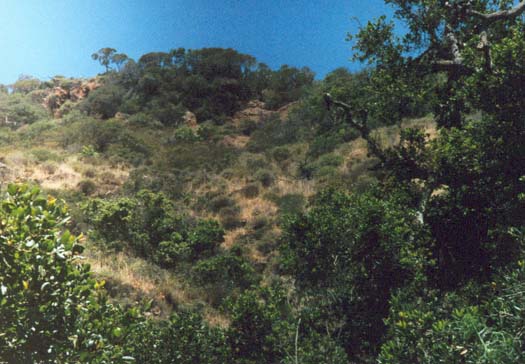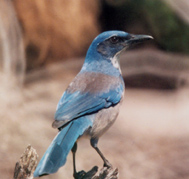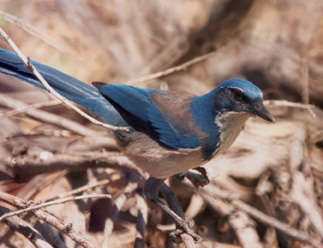![]()
Island Scrub-Jay
![]()

Santa Cruz Island
Got your virtual lifer Jay yet? Its there!

Photo by Mitch Heindel - © 2001
![]()

Photo by Mitch Heindel - © 2001
![]()

Photo by Mitch Heindel - © 2001
Santa Cruz Island and the big blue tick
It would be true to say most of the birders
going to the island these days, would not be,
if it were not for the "sitting duck" big blue
tick. Which, is a shame because its home is
such a spectacular place on its own. There is
so much more than the jay to see there. It's
like going back 2-300 years in time, to what
it must have been like throughout the coast
and foothills of the California mainland,
before we "improved and developed" it.
There are a myriad of unique subspecies
on the Island and it is a case study in
island Biology and evolution. From the
CA Slender Salmander with its double row of
blue spots going down its black back, to
the biggest, bluest Scrub-Jay you'll ever
see, there are many wonders. The butterflies
always impress me in their numbers in June.
Of course getting there is always fun, a boat
ride from Ventura via one of Island Packers
vessels, the official NPS concessionaire. After
the initial bouncy area nearshore over the sandy
shallows, it's usually not that bad a ride.
Pelagic birding is almost always good in the
Santa Barbara Channel, and anything seen in
SoCal, could be seen on the way.
In the area you cross, there have been Boobies,
Tropicbird, and in April it's excellent for
Xantus's Murrelet. One year on the way, in June,
we had a Fork-tailed Storm-Petrel! In summer,
you might see Blue and Humpback Whales.
At Scorpion's Landing at the east end, you usually
have to walk upcanyon at least to the Eucalyptus
grove (1/2 mile), if not further, to find jays,
though sometimes they are at the ranch. At
Prisoner's, on the north shore, where the annual
LAAS trip lands, the jays are essentially at the
beach. Either way, with the wet landings through
the surf, wet feet are not rare! So prepare!
Bring extra socks for when you get back on board.
I think it is as important as looking at the jays,
to look at and listen to, the other endemic island
bird subspecies. A couple are purported not to be,
allegedly mainland subspecies, but I wonder...
Here is a list of them.... Note that most are found
on one or more of the other channel islands, and the
Hummer and Warbler on the mainland too. The P/S
denote whether more likely at Prisoner's or Scorpions.
The big blue jay is included with the others here....
Species - S.Cruz Is. / mainland
Allen's Hummingbird - sedentarius / sasin P/S
Loggerhead Shrike - anthonyi / gambeli S
Island Scrub-Jay - insularis / californica P
Western Flycatcher - insulicola / difficilis P
Horned Lark - insularis / actia S
Bewick's Wren - nesophilus / correctus P
Orange-crowned Warbler - sordida / lutescens P
Rufous-crowned Sparrow - obscura / canescens P/S
Song Sparrow - clementae / cooperi P
The Spotted Towhee (P) and Rock Wren (S) are alleged
to be mainland subspecies megalonyx, and obsoletus,
respectively. They certainly can sing differently
than mainland birds. Listen to these, and best if
you go hear mainland birds the day before (or after)
you go to island. If Cruz's Spotted Towhees are
megalonyx, I can't believe Palos Verde's are.
It is very interesting to compare to the mainland,
which species are present on the island, versus
those which are missing. Consider the following..
Missing from Santa Cruz Isl., except as vagrants are:
California Thrasher, Western Bluebird, Oak Titmouse
Western Screech-Owl, Nuttall's Woodpecker, and
Wrentit. The same list is missing from the former
Channel Island, the Palos Verdes Peninsula!
The island has extensive oak and pine forests, so
the list of resident or nesting species is interesting.
Present are Acorn Woodpecker, N.(Red-shafted) Flicker
Canyon Wren, Blue-gray Gnatcatcher, Saw-Whet Owl,
Hutton's Vireo, Bushtit, Red-breasted Nuthatch, Anna's
Hummingbird, and in summer Black-headed Grosbeak, and
even Grasshopper Sparrow and Red Crossbill have bred.
Interesting too, is the list of which species are not
present nesting there (at least as of the last NPS
Checklist). Crow, Common Yellowthroat, Black-chinned
Hummingbird, American Goldfinch, Robin, House Wren,
Hooded or Bullock's Oriole, and Cooper's Hawk. These
apparently were never able to colonize the island.
You would most enjoy going over and camping there for
a night and having a couple days to explore around
and see more than the typical few hour landing allows.
Camping permits are available through NPS, adjacent to
Island Packers in Ventura Harbor. You backpack in/out.
Listen to those Western Flycatchers there! WOW ! They
can do a three-pitched weee-ooo-weeet, like the old
plastic kiddie slide flutes. The Song Sparrows,
Bewick's Wrens, and Spotted Towhees, all can sound
remarkably different than the mainland birds. But,
not all their calls... some are very similar, others
very different. How little we know.... Note the
Western (P-s) Flycs., are as often as green and
yellow as any others, and are an argument for it
being "Western" Flycatcher. And finally I am compelled
to comment on Sibley's description of the Jay's calls.
They DO NOT sound like mainland birds. They are very
and obviously different, and especially quieter overall.
Have fun, enjoy the birds, and don't just go
to tick the big blue sitting duck of a tick (jay)..
Notice (Viva le!) the island difference! Remember,
you never know what you might get to 'count' someday.
![]()
Top of Page
Pelagic Index Page
Home